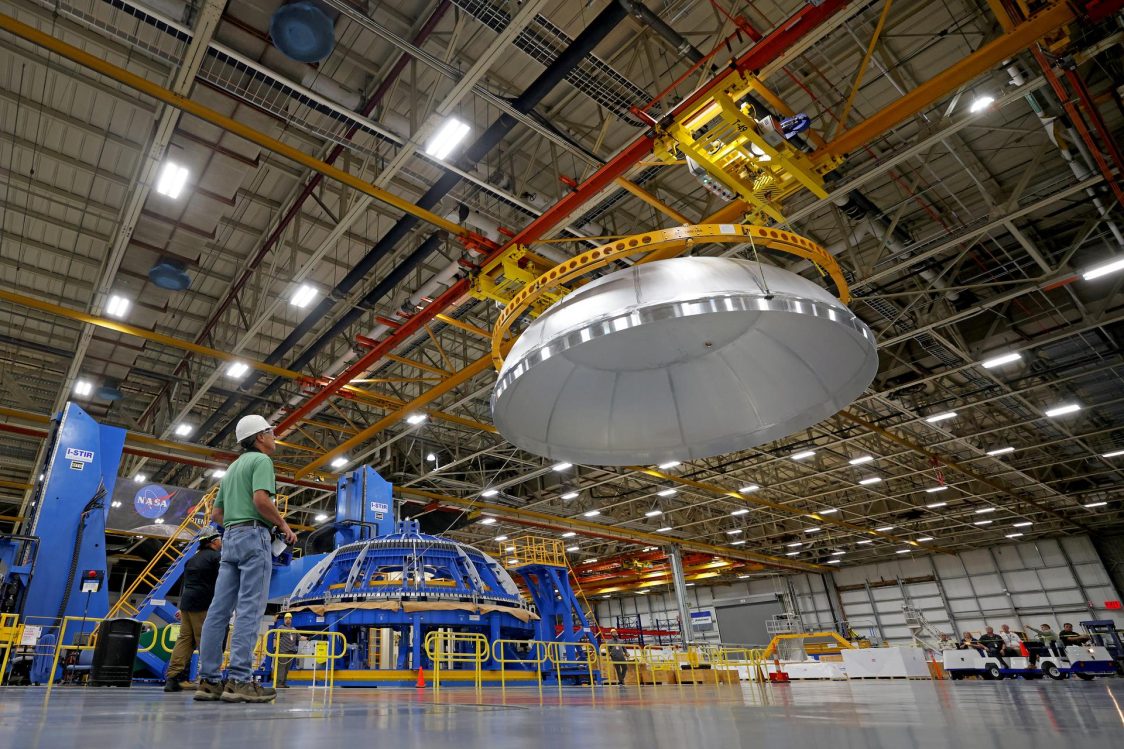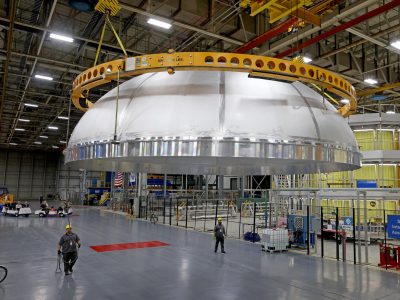Futuramic’s tooling for NASA’s Space Launch System (SLS) was used to complete the welding of the Artemis IV Liquid Oxygen Tank Forward Dome at NASA’s Michoud Assembly Facility. Many Futuramic tools were used to complete this job, including the Dome Rounding Tool, Overhead Lift Equipment, Gore Weld Tool, Circumferential Weld Tool, Segmented Ring Weld Tool, and the Plug Welders.
“Teams completed welding of the liquid oxygen dome for the core stage of a future SLS (Space Launch System) rocket at NASA’s Michoud Assembly Facility in New Orleans. The dome, which will cap off the forward end of the liquid oxygen tank, was lifted off of the robotic weld tool and moved to an assembly area for the next phase of production. Later, crews will add the forward dome to join the two barrels and the aft dome to complete the liquid oxygen tank. The flight hardware will be used for Artemis IV, the first flight of SLS in its Block 1B configuration.
The SLS core stage liquid oxygen tank holds 196,000 gallons of super-cooled liquid propellant. The SLS core stage is made up of five unique elements: the forward skirt, liquid oxygen tank, intertank, liquid hydrogen tank, and the engine section. The liquid oxygen and the liquid hydrogen tanks will provide propellant to the four RS-25 engines to produce more than two million pounds of thrust to help launch NASA’s Orion spacecraft, astronauts, and supplies beyond Earth’s orbit to the Moon.” – via NASA Image and Video Library
Circumferential Dome Welding Tool (CDWT)
 This image captures the successful removal of a finished Liquid Oxygen Tank Forward Dome from Futuramic’s Circumferential Dome Welding Tool (CDWT). This tool positions and secures the Y-Ring, Gore Dome and Upper Dome for circumferential Friction Stir Welding.
This image captures the successful removal of a finished Liquid Oxygen Tank Forward Dome from Futuramic’s Circumferential Dome Welding Tool (CDWT). This tool positions and secures the Y-Ring, Gore Dome and Upper Dome for circumferential Friction Stir Welding.
Completed Forward Dome Photos from NASA’s Michoud Assembly Facility
- Image credit: NASA / Michael DeMocker
- Image credit: NASA / Michael DeMocker
About Artemis IV
The Artemis IV mission is the fourth planned mission of the Artemis program and will see two astronauts land on the Moon as well as deliver the first ESA module for the Gateway: I-Hab. The launch will be on a Space Launch System rocket from the usual Launchpad 39B at NASA’s Kennedy Space Center in Florida, USA. The mega Moon rocket will propel four astronauts inside Orion to the Moon but Artemis IV will be the first mission to use a new second stage, replacing the interim cryogenic propulsion stage used on the first three Artemis missions. The advanced exploration upper stage booster increases the SLS’s rocket’s capability from 27 to 42 tonnes, allowing for more hardware to be sent to the Moon with the Orion spacecraft.




